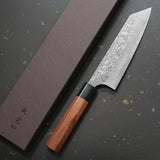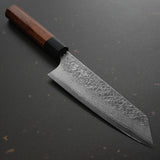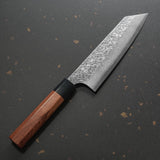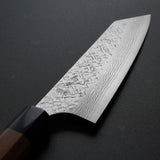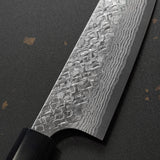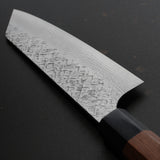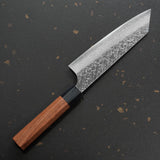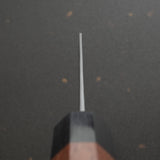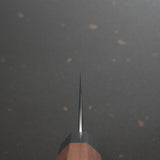Yoshimi Kato VG10 Hammered Damascus Bunka Knife 170mm Honduras Rosewood
Blacksmith: Yoshimi Kato
Type: Bunka Knife (Double bevel edged)
Blade Material: VG10 Clad Hammered Damascus Stainless Steel
Core: VG10 (Cobalt Alloy)
Blade Length: approx 170 mm
Blade Width: approx 47 mm
Thickness of Spine: approx max 2.5 mm
Overall Length: approx 312 mm
Weight: approx 137g (4.8oz)
Handle: Honduras Rosewood
HRC: 61
Made in Japan
Echizen Uchi Hamono, a prestigious designation bestowed by the Minister for Economy, Trade and Industry, boasts a 700-year-old tradition of Japanese knife-making in Echizen City. These meticulously forged knives are renowned for their exceptional chip resistance and remarkable edge retention, a testament to their remarkably homogeneous material structure evident under microscopic examination.
The elegant "Sumi Nagashi" wave pattern, a hallmark of Japanese cutlery culture, is a true treasure. Like a "Katana", the blade is meticulously crafted by layering low and high carbon stainless steel, resulting in a unique and mesmerising pattern. Each blade exhibits a distinctive Damascus pattern, forged by skilled craftsmen using a belt hammer. The hammered design not only enhances the appearance of the blade, but also adds a sense of luxury and showcases the beauty of Japanese craftsmanship, while also enhancing food release. This is more than just a kitchen knife; it's a true work of art.
The blade shape is called "HAMAGURI-BA" in Japanese. "HAMAGURI" means clam, and "BA" refers to the blade or edge. This shape allows the knife to cut ingredients smoothly and its provides strength and durability.
KATO UCHI(Forging) HAMONO(Cutlery) SEISAKUSHO(Factory)
This company was established on 1st April 1953. The founder, Mr Kintaro Kato, was born in October 1914. He started the production of forged kitchen knives in 1928. The company has built up experience and knowledge of knife making over many years. President Hiroshi Kato received the certificate of traditional craftsman in February 2008.
About "VG-10"
VG-10 is a high-carbon stainless steel that contains cobalt, offering exceptional sharpness and wear resistance, making it a popular choice among professionals. Developed by Takefu Special Steel Co., Ltd., VG-10 features a hard core with softer steel on the sides, striking the perfect balance between sharpness and ease of sharpening. For efficient maintenance, a ceramic sharpening stone is recommended.
Take a look at our Ceramic Sharpening Stone.
NOTES:
The core steel is VG10, and the side steel is rust-resistant; however, please be sure to wash, wipe, and dry the knife thoroughly after each use. If rust appears on the blade, use a cleanser or take it to a sharpening service (note that scratches may occur).
Avoid twisting the edge or striking the blade. Do not cut frozen foods or bones, as the thinner, sharper edge of Japanese knives may chip or break. Since Japanese knives are handcrafted, slight scratches may appear naturally.










